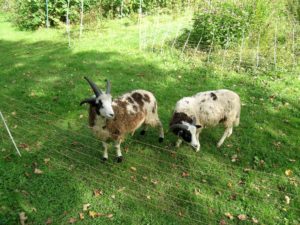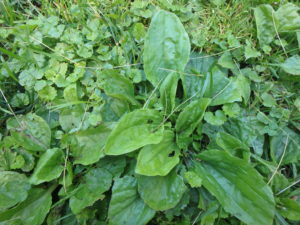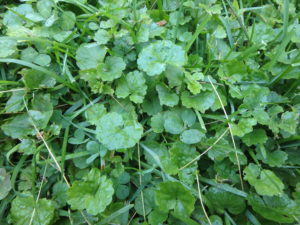How to Have a Better Lawn
Believe it or not, I once ate my lawnmower. No, not the Briggs and Stratton kind. I had purchased a pair of Jacobs sheep to keep my lawn trim for a season. At the end of the season they were off to the butcher, and came home freezer wrapped. It was an interesting experience, but not one I would recommend.
These rascals didn’t do an even job of cutting the lawn, and loved to butt me when I entered their pen.
To keep sheep as lawnmowers, I used a portable electric fence. It worked, but the sheep were always looking for trouble – they were teenage boy sheep, after all. They tried to (and did) reach through the fence to eat my flowers, get out of their enclosure, and trick me into thinking they were not interested in my trees and shrubs – only to attack them when I least expected it.
What is it with our fascination with lawns? Historically, lawns were maintained largely by the landed gentry. Peasants had neither the time nor the land for cultivating lawns. Maybe we all, deep down, want to be part of the nobility. But I think we like lawns because they promote tranquility and they are, with the advent of mowers, the easiest part of our landscape to maintain.
I am a minimalist when it comes to lawns. I don’t want a chemical-dependent lawn to fuss over. No fertilizers, fungicides, insecticides or moss killers for me. That said, there are things you can do to improve your lawn without too much trouble, and I think I have tried them all.
Over-seeding is one way to help your lawn. If you have places where the lawn is thin, first put down half an inch of fine compost or top soil. You will have to purchase this, I suspect, as homemade compost usually contains lumps like egg shells and undigested orange peels. Many garden centers have nice compost for sale by the tractor scoop ready for your pick-up truck, and all have bagged compost.
Fling compost over the lawn with a shovel, and spread it out with a lawn rake. Then apply lawn seed, and drag the lawn rake over the seed and compost – with the rake tines up, not down. The tines will mix the seeds and compost or soil.Where you have shady lawn, buy lawn seed for shady places.
Watering is key. Seeds need moisture to germinate, and a hot sunny day will dry out seeds quickly. Some people like to spread a thin layer of straw over the seeded area to shade the seeds and minimize drying. At this time of year it will take about a week for grass to start growing (but much longer in the spring when the soil is cold.) Water every day unless it rains. I generally plant when 3 days of rainy weather is forecast.
What about fertilizer? Most states prohibit using phosphorous-containing fertilizers on lawns (to protect streams and ponds). ) On a bag of 5-10-5 fertilizer, for example, it’s the middle number (10). There are now special fertilizers for lawns, but if you are adding compost, it will help provide adequate nutrition for your lawn.
Grass grows best when the soil is around neutral.
For about $5 you can buy a soil pH test kit to see if yours is in the range of 6.0 to 7.0, which is ideal. The kits are easy to use: put some soil into a glass vial, add their magic powder, then add water. Shake, and the water will change color. You just decide which of the pictures on the kit best matches the color of your solution. They say to use distilled water, as it won’t affect the results. It’s available at the pharmacy.
If your soil is acidic (technically below 7.0), you may want to add some limestone to the lawn. But don’t bother unless the soil is quite acidic, say in the 4.5 to 5.9 range. Read the directions on the bag, and add the appropriate amount. I just use a can and sprinkle it over small areas.
Height of the grass is important to a lawn, too. I once got to interview Joe Mooney, the head groundskeeper at Fenway Park, home of my beloved Red Sox. He maintained the infield at a height of three quarters of an inch! Lawn that short stresses the plants, so he also had a dungeon under the stands full of chemical fertilizers and fungicides.
The longer you keep the lawn, the more food a grass plant can make, so the healthier it will be. Cutting grass at three inches is good. Yes, shorter looks neater, perhaps, but taller grass will also help shade out annual weeds and crabgrass.
What about those weeds? Does it really matter that you have some? People write to me all the time complaining about Creeping Charlie (Glechoma hederacea) in their lawns. Charlie is like death and taxes, you can’t avoid him without killing everything else, including your lawn grasses. So ignore Creeping Charlie. I also ignore plantain, dandelions and other weeds.
Accept weeds, and your blood pressure will go down, and your summer will be better. “If it is green and I can mow it, it’s a lawn.” That’s my motto. The only weeds I dig out are thistles, as they hurt bare feet! Chemicals? I don’t want my grandkids and pets absorbing them as they walk barefoot across the lawn.
Read Henry’s blog athttps://dailyuv.com/





